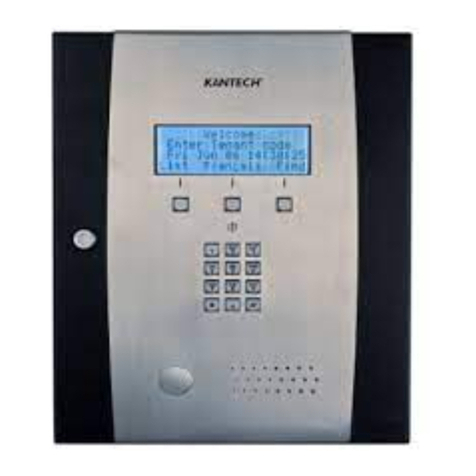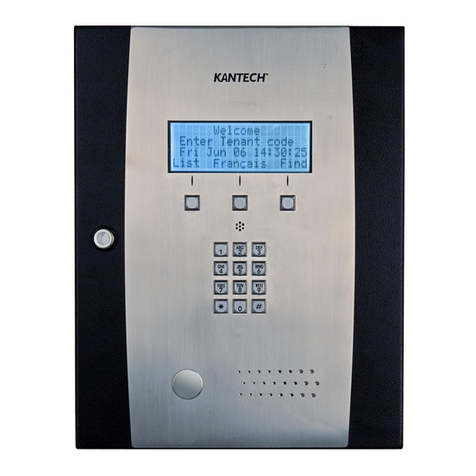
DN1769-1809 v
Kantech Telephone Entry System Installation Manual
KANTECH WARRANTY TERMS
For KANTECH Products Provided With or Without Components or Software
KANTECH Products purchased with or without Components and Software is copyrighted and is purchased under the following limited
warranty terms:
Sensomatic Electronics, LLC (“Kantech”) warrants the original purchaser that for a period of 2 years from the date of purchase, the product shall be free of
defects in materials and workmanship under normal use. During the warranty period, Kantech shall, at its option, repair or replace any defective product
upon return of the product to its factory, at no charge for labour and materials. Any replacement and/or repaired parts are warranted for the remainder
of the original warranty period or ninety (90) days, whichever is longer. The original purchaser must promptly notify Kantech in writing that there is
defect in material or workmanship, such written notice to be received in all events prior to expiration of the warranty period. There is absolutely no
warranty on software, and all software products are sold as a user license under the terms of the software license agreement included with the product.
The Customer assumes all responsibility for the proper selection, installation, operation and maintenance of any products purchased from KANTECH.
Custom products are only warranted to the extent that they do not function upon delivery. In such cases, KANTECH can replace or credit at its option.
International Warranty
The warranty for international customers is the same as for any customer within Canada and the United States, with the exception that Kantech shall not
be responsible for any customs fees, taxes, or VAT that may be due.
Warranty Procedure
To obtain service under this warranty, please return the item(s) in question to the point of purchase. All authorized distributors and dealers have a
warranty program. Anyone returning goods to Kantech must first obtain an authorization number. Kantech will not accept any shipment whatsoever for
which prior authorization has not been obtained.
Conditions to Void Warranty
This warranty applies only to defects in parts and workmanship relating to normal use. It does not cover any of the following, the occurrence of
which will void this warranty:
• damage incurred in shipping or handling;
• damage caused by disaster such as fire, flood, wind, earthquake or lightning;
• damage due to causes beyond the control of Kantech, such as excessive voltage, mechanical shock or water damage;
• damage caused by unauthorized attachment, alterations, modifications or foreign objects;
• damage caused by peripherals (unless such peripherals were supplied by Kantech.);
• defects caused by failure to provide a suitable installation environment for the products;
• damage caused by use of the products for purposes other than those for which it was designed;
• damage from improper maintenance; and
• damage arising out of any other abuse, mishandling or improper application of the products.
Items Not Covered by Warranty
In addition to the items which void the Warranty, the following items shall not be covered by Warranty: (i) freight cost to the repair centre; (ii) products
which are not identified with KANTECH's product label and lot number or serial number; (iii) products disassembled or repaired in such a manner as to
adversely affect performance or prevent adequate inspection or testing to verify any warranty claim. Access cards or tags returned for replacement
under warranty will be credited or replaced at KANTECH's option. Products not covered by this warranty, or otherwise out of warranty due to age, misuse,
or damage shall be evaluated, and a repair estimate shall be provided. No repair work will be performed until a valid purchase order is received from the
Customer and a Return Merchandise Authorization number (RMA) is issued by KANTECH’s Customer Service. Kantech’s liability for failure to repair the
product under this warranty after a reasonable number of attempts will be limited to a replacement of the product, as the exclusive remedy for breach of
warranty. Under no circumstances shall Kantech be liable for any special, incidental, or consequential damages based upon breach of warranty, breach of
contract, negligence, strict liability, or any other legal theory. Such damages include, but are not limited to, loss of profits, loss of the product or any
associated equipment, cost of capital, cost of substitute or replacement equipment, facilities or services, down time, purchaser’s time, the claims of third
parties, including customers, and injury to property. The laws of some jurisdictions limit or do not allow the disclaimer of consequential damages. If the
laws of such a jurisdiction apply to any claim by or against KANTECH, the limitations and disclaimers contained here shall be applicable to the greatest
extent permitted by law. Some states do not allow the exclusion or limitation of incidental or consequential damages, so that the above may not apply to
you.
Disclaimer of Warranties
This warranty contains the entire warranty and shall be in lieu of any and all other warranties, whether expressed or implied (including all implied
warranties of merchantability or fitness for a particular purpose) and of all other obligations or liabilities on the part of Kantech. Kantech neither assumes
responsibility for, nor authorizes any other person purporting to act on its behalf to modify or to change this warranty, nor to assume for it any other
warranty or liability concerning this product. This disclaimer of warranties and limited warranty are governed by the laws of the state of New York.
WARNING:
Kantech recommends that the entire system be completely tested on a regular basis. However, despite frequent testing, and due to, but not limited to,
criminal tampering or electrical disruption, it is possible for this product to fail to perform as expected.






























